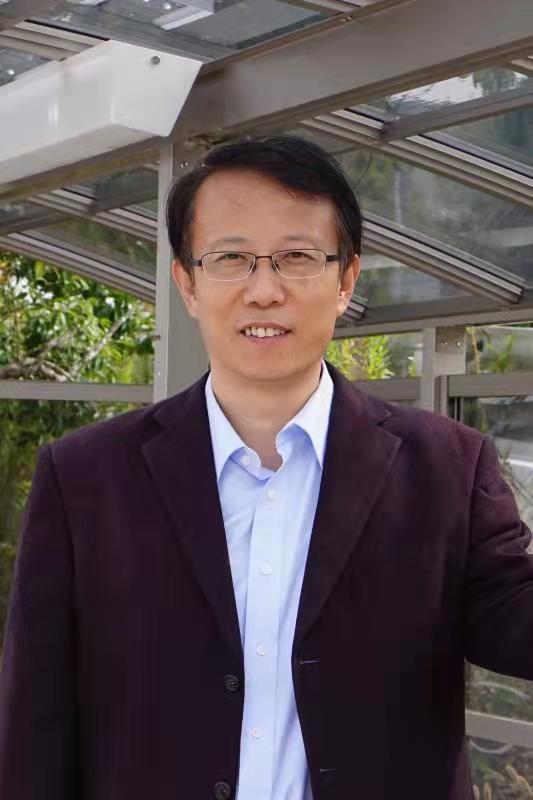
成果介绍:中国农业大学6163银河.net163.am学术委员,Journal of Food Science编辑。目前主要从事蛋白质化学与营养以及智能生物纳米材料制备方面的研究,主要研究对象为铁蛋白(ferritin)。在Chem. Soc. Rev., Nature Communications, J. Am. Chem. Soc., Angew. Chem. Int. Ed., Nano Letters, ACS Nano等发表 SCI 论文约150 篇。主持国家自然科学基金重点项目、面上项目7项,获授权国家发明专利 12 项。
邮箱:gzhao@cau.edu.cn
教育经历
1988.9-1992.7:本科毕业于山西大学化学系有机化学专业
1992.9-1995.7:硕士毕业于山西大学分子科学研究所生物无机化学专业
1995.9-1998.7:博士毕业于南开大学化学系物理化学专业
工作经历
2000.1-2002.7:在美国University of New Hampshire在Dr. N. Dennis Chasteen实验室进行博士后研究
2003.1-2004.7: 中国农业大学6163银河.net163.am,副教授
2004.7-2005.12:在美国University of New Hampshire Dr. N. Dennis Chasteen实验室进行博士后研究
2008.1-至今:中国农业大学6163银河.net163.am,教授,博士生导师。
研究领域及方向
实验室的研究领域主要涉及食品营养与食品科学;研究方向主要包括:蛋白质化学与营养;蛋白质自组装机制及智能生物纳米材料制备。
教授课程
主讲蛋白质化学(研究生)、食品化学(本科生)及Advanced Biochemistry(留学生)课程。
著作
《Mineral Containing Proteins》 Springer
代表性论文
Lv C., Zhang X., Liu Y., Zhang T., Chen H., Zang J., Zheng B., Zhao G.* Redesign of protein nanocages: the way from 0D, 1D, 2D to 3D assembly. Chemical Society Review, 2021, 50, 3957–3989.
Zhang X., Liu Y., Zheng B., Zang J., Lv C., Zhang T.*, Wang H., Zhao G*. Protein interface redesign facilitates the transformation of nanocage building blocks to 1D and 2D nanomaterials. Nature Communication, 2021, 12, 4849.
Zeng R., Lv C., Wang C., Zhao G*. Bionanomaterials based on protein self-assembly: Design and applications in biotechnology. Biotechnology Advances, 2021, 52, 107835.
Gu C., Zhang T., Lv C., Liu Y., Wang Y., Zhao G.* His-Mediated Reversible Self-Assembly of Ferritin Nanocages through Two Different Switches for Encapsulation of Cargo Molecules. ACS Nano, 2020, 14, 17080-17090.
Zang J., Chen H., Zhang X., Zhang C., Guo J., Du M.*, Zhao G.* Disulfide-mediated conversion of 8-mer bowl-like protein architecture into three different nanocages. Nature Communication, 2019, 10, 778.
Zheng B., Zhou K., Zhang T., Lv C., Zhao G.* Designed Two- and Three-Dimensional Protein Nanocage Networks Driven by Hydrophobic Interactions Contributed by Amyloidogenic Motifs. Nano Letters, 2019, 19, 4023-4028.
Wang W., Wang L., Chen H., Zang J., Zhao X., Zhao G.*, Wang H.* Selective Elimination of the Key Subunit Interfaces Facilitates Conversion of Native 24-mer Protein Nanocage into 8-mer Nanorings. Journal of the American Chemical Society, 2018, 140, 14078-14081.
Chen H., Zhou K., Zhao G.* Gold nanoparticles: From synthesis, properties to their potential application as colorimetric sensors in food safety screening. Trends in Food Science & Technology, 2018, 78, 83-94.
Zhou K., Zang J., Chen H., Wang W., Wang H., Zhao G.* On-Axis Alignment of Protein Nanocage Assemblies from 2D to 3D through the Aromatic Stacking Interactions of Amino Acid Residues. ACS Nano, 2018, 12, 11323-11332.
Zhang S., Zang J., Chen H., Li M., Xu C., Zhao G.* The Size Flexibility of Ferritin Nanocage Opens a New Way to Prepare Nanomaterials. Small, 2017, 1701045, 1-6.
Zang J., Chen H., Zhao G.*, Wang F., Ren F. Ferritin cage for encapsulation and delivery of bioactive nutrients: From structure, property to applications. Critical Reviews in Food Science and Nutrition, 2017, 57, 3673-3683.
Zhang S., Zang J., Zhang X., Chen, H., Mikami B.*, Zhao G.* “Silent” Amino Acid Residues at Key Subunit Interfaces Regulate the Geometry of Protein Nanocages. ACS Nano, 2016, 10, 10382-10388.
Zhang S., Zang J., Wang W., Chen H., Zhang X., Wang F., Wang H.*, Zhao G.* Conversion of the Native 24-mer Ferritin Nanocage into Its Non-Native 16-mer Analogue by Insertion of Extra Amino Acid Residues. Angewandte Chemie International Edition, 2016, 55, 16064-16070.
Zang J., Li C., Zhou K., Dong H., Chen B., Wang F., Zhao G.* Nanomolar Hg2+ Detection Using β-Lactoglobulin-Stabilized Fluorescent Gold Nanoclusters in Beverage and Biological Media. Analytical Chemistry, 2016, 88, 10275-10283.
Chen H., Zhang S., Xu C., Zhao G.* Engineering protein interfaces yields ferritin disassembly and reassembly under benign experimental conditions. Chemical Communications, 2016, 52, 7402-7405.
近期授权专利
(1)一种脑组织甲基汞的活体检测方法 (CN202010069573.5,第一发明人)
(2)一种Tk-Rubisco突变体、线性组装材料及其制备方法和应用 (CN112941061B,第一发明人)
(3)一种水分散型透明虾青素乳液及其制备方法 (CN201610375390.X,第一发明人)
(4)一种非热加工蒜泥的制备方法 (CN201510266518.4,第一发明人)
(5)一种靶向纳米声敏剂及其制备方法 (CN201410334178.X,第一发明人)
(6)一种天然脂肪酸盐和多聚赖氨酸水凝胶及其制备方法(CN201410166685.7,第一发明人)
近期主要主持科研项目
(1)主持国家自然科学基金面上项目“食源铁储藏蛋白自组装形成笼形结构的机制研究”,项目编号:31972018。
(2)主持国家自然科学基金重点项目“热加工诱导食源铁储藏蛋白结构变化及对其铁吸收机制的影响” 项目编号:31730069。
(3)主持国家自然科学基金“食源脂溶活性分子铁蛋白包埋物的制备及其细胞吸收机理”,项目编号:31471693。
(4)主持国家自然科学基金“EP肽段诱导大豆铁蛋白降解机理及其生物学功能研究” 项目编号:31271826。
(5)主持国家自然科学基金“酚酸诱导大豆铁蛋白铁还原释放机理及其产生的生物学效应研究”,项目编号:31671805。
(6)主持国家自然科学基金“新型补铁功能因子—铁蛋白的聚合机制及其调控研究“,项目编号:30972045。
(7)主持国家自然科学基金,项目名称为“功能性天然‘腊八蒜’色素形成机理”的研究,基金代号为30570181。
实验室简介
本实验室主要研究方向主要包括:
(1)蛋白质化学与营养。食源铁储藏蛋白(ferritin)以及含锌元素蛋白的结构、功能及其吸收代谢机制是我们实验室的重要研究方向。铁在人体的微量元素中含量排在第一位,锌离子紧随其后,足见这两个矿物元素对人体的重要性。随着我国经济的持续发展,百姓的温饱问题已经基本解决,然而,我国国民的营养状况不容乐观,营养素特别是铁、锌微量元素缺乏较为普遍。而植物铁蛋白以及锌储藏蛋白结构、功能以及营养吸收代谢机制的阐明,将为新型铁、锌矿物元素补充剂的开发铺平道路。我们实验室建立了适用于金属储藏蛋白结构、功能以及吸收的研究平台,旨在开发天然、新型、高效、安全的铁以及锌营养元素补充剂,为提高国民的营养健康状况作出贡献。
(2)蛋白质自组装机制及智能医用生物纳米材料制备。生物大分子特别是蛋白质是组成所有生命的分子基础。通过生物大分子之间有序、准确的自组装和识别过程,生命得以创造且千姿百态。从分子层面重新设计和利用生物大分子材料及其自组装原理,创造出既符合自然规律又满足人类需求的新型生物材料是未来纳米领域的发展方向,且展现出诱人的前景。本课题组主要致力于以天然笼型蛋白质的自组装机制,及其为原料设计和制备智能生物纳米材料的研究。结合蛋白质工程技术、化学合成技术以及计算机辅助设计等手段对天然蛋白质进行改造、设计从而指导其进行有序的自组装,制备出能够用于精准营养成分投递、靶向药物传递,生物成像,癌症诊疗等领域的新型智能纳米材料。